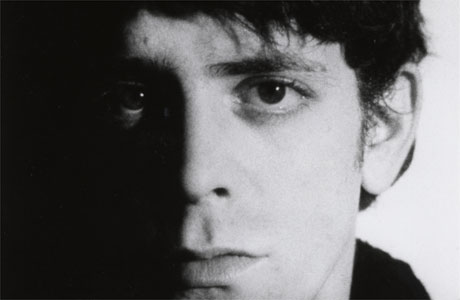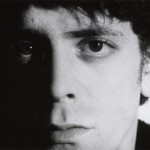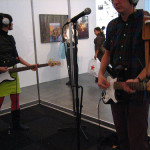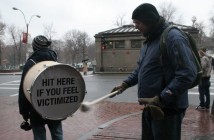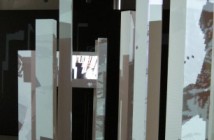SYMPATHY FOR THE DEVIL @ MUSéE D'ART CONTEMPORAIN DE MONTRéAL
The Musée d'art contemporain de Montréal is featuring an exciting traveling exhibition devised by Dominic Molon, curator of Chicago’s Museum of Contemporary Art. Sympathy for the Devil: Art and Rock and Roll Since 1967 documents the relationship between art and rock music, featuring experimental art from the past four decades as well as contemporary pieces inspired by the rock and roll legacy. The show features over 130 pieces by more than 60 different artists from around the world and is an overwhelming sensory experience. Jarring experimental rock music blares out of audio speakers, setting the mood for neon lights, larger-than life works of art, and haunting video installations.
Sympathy for the Devil demonstrates how art and music spark a dialogue in the creative community all over the world. The show includes video installations from Andy Warhol’s famous series of Screen Tests starring rock musicians Lou Reed, Maureen Tucker, John Cale, Sterling Morrison and Nico. In these eerie documentaries, Warhol asked his subjects to stare into the camera without blinking for several minutes of unbroken footage. The unusual imagery is accompanied by audio clips of abrasive experimental rock music, providing a simultaneous outlet for both ground breaking art and music. Warhol filmed various artists, writers, musicians, and designers who were regulars at Warhol’s studio – the Factory. The Factory itself represented a cross-section where different types of artists would meet to share ideas and inspiration.
Several artists featured were involved in experimental music while they developed their art. Robert Longo is well known for Untitled (Men in Cities), his famous series from the 1980s. While working on his art, Longo was also involved in an experimental punk band called Robert Longo's Menthol Wars. His large graphite and charcoal drawings feature men and women in business suits dancing wildly and contorting their silhouettes. Each figure’s face is turned away or hidden behind a wild limb or starched white shirtsleeve. The result is a series of striking black and white compositions that articulate the feeling of chaos that accompanied this unconventional music’s impact on the working class. The stark contrast of the figures conservative clothes and out-of-control movements demonstrates how experimental music symbolized a radical break from conventional society.
A large portion of the artwork is inspired by the ideology and sensation of music that is counter-cultural and controversial. Adam Pendleton constructed a massive grid entitled Sympathy for the Devil in 2007 inspired by punk music of the late 1970s and early 1980s. Imagery from album art and promotional posters are enlarged, cropped, and resized to highlight the avant-garde and risqué themes of this musical era. Highly sexualized imagery of expletive gestures, flamboyant style and audacious expressions are blown up and stacked in daunting repetition to create a sense of overwhelming rebellion from the times.
Jim Lambie is another contemporary artist inspired by the philosophy of music from the past. His installations Pinball Wizard and The Byrds (Love in a Void) play off each other and create a mind-bending, psychedelic illusion which mirrors the sense of disruption caused by 1960s rock music. A three-foot tall bird sculpture is covered in blaringly bright, oozing paint that drips down and melds into a more obsessively intricate striped pattern that runs through the entire floor. The dizzying installation is complimented by jarring background noise from audio pieces in the exhibition. The whole experience evokes the loud exchange of ideas that went on during this era, and the abrasive quality of experimental art and music.
One of the most exciting things about the exhibition is the interactive nature of so many of the works. Amidst blaring music, films and interviews, there are several interactive installations. In Christian Marclay’s Untitled, dozens of Vinyl records line the floor of an entire room and beg to be walked over, read, scuffed up, and discussed. In the World portion of the exhibit, Rirkrit Tiravanija's Untitled 1996 (Rehearsal Studio No. 6 Silent Version) serves as an interactive recording studio on display for museum visitors. The piece is a Plexiglas studio that includes microphones, a guitar, a bass, an electric drum kit, and recording equipment. Any eager musicians can reserve an hour to play and record their musings, while museum visitors are welcome to watch and listen in on headphone sets. In the pristine glass walls and museum setting, a casual recording session transforms into an inspired performance piece, putting the creative process on display. Surrounded by work that retraces the history of rock and roll from the past four decades, this piece contemplates the relationship between art and music as it happens here and now.
It is interesting to explore music that was once so defiantly counter-cultural in the intellectual setting of an art museum. By inspiring contemporary artists today, the music takes on new meaning as a part of our cultural history. While times have changed, the ideas of the rock movement are still present. It is a fairly new anomaly that today’s youth actually looks to music of the past rather than what is being created today, citing Led Zeppelin, Queen and the Rolling Stones among their favorite music artists. We’re also familiar with contemporary artists taking a cue from the past with musical rifts sampled from songs that topped the charts years ago resurfacing in current pop hits. However the message of the music is lost in translation, since pop records aspires to break sales records as opposed to challenging societal norms. However, new and innovative art inspired by rock culture is one way that creative minds continue to defy expectations, explore new ideas, and challenge conventional society.
- Andy Warhol, Screen Test: Lou Reed, 1966.
- Rirkrit Tiravanija, Untitled 1996 (Rehearsal Studio No. 6 Silent Version), Plexiglas walls, metal framework, guitar, bass guitar, electronic drum kit, microphones, recording equipment, headphones and carpet.
Musée d'art contemporain de Montréal
"Sympathy for the Devil: Art and Rock and Roll Since 1967" is on view until January 11th, 2009 at the Musée d'art contemporain de Montréal, Quebec.
All images are courtesy of the Musée d'art contemporain de Montréal.

